Impact Mineralization of Chokeberry and Cranberry Fruit Juices Using a New Functional Additive on the Protection of Bioactive Compounds and Antioxidative Properties
Abstract
1. Introduction
2. Results and Discussion
2.1. Determination of Basic Physicochemical Parameters
2.2. Determination of Ash and Mineral Compounds
2.3. Determination of Polyphenolic Compounds
2.4. Determination of Antioxidant Activity
2.5. Determination of Sensory Evaluation
2.6. Principal Components Analysis
3. Materials and Methods
3.1. Reagent and Standard
3.2. Materials
3.3. Technology
3.4. Determination of Ash and pH
3.5. Determination of Color
3.6. Determination of Mineral Content by ICP-OES Analysis
3.7. Determination of Organic Acids
3.8. Determination of Polyphenolic Compounds
3.9. Determination of Antioxidant Activity
3.10. Sensorian Evaluation
3.11. Statistical Analysis
4. Conclusions
Supplementary Materials
Author Contributions
Funding
Conflicts of Interest
References
- Trziszka, T.; Różański, H. Żywność funkcjonalna i nutraceutyki w profilaktyce chorób cywilizacyjnych. Herbalism 2015, 1, 9–19. [Google Scholar] [CrossRef]
- Korbutowicz, T. Żywność funkcjonalna na rynku światowym. Studia Pr. Wneiz Us 2018, 53, 209–220. [Google Scholar] [CrossRef]
- Waszkiewicz-Robak, B.; Biller, E.; Obiedzinski, M.W. Trendy na rynku napojów bezalkoholowych. Ferment. Fruit Veg. Ind. 2017, 61, 28–30. [Google Scholar] [CrossRef]
- Tarko, T.; Duda-Chodak, A.; Semik-Szczurak, D.; Błach, A. Związki bioaktywne w napojach owocowych i warzywnych. In Rola Procesów Technologicznych w Kształtowaniu Jakości Żywności; Polish Society of Food Technologists: Krakow, Poland, 2016; pp. 135–142. ISBN 978-83-937001-6-5. [Google Scholar]
- Gryszczyńska, B.; Iskra, M.; Gryszczyńska, A.; Budzyń, M. Aktywność przeciwutleniająca wybranych owoców jagodowych. Adv. Physiother. 2011, 4, 265–274. [Google Scholar]
- Michalak-Majewska, M.; Żukiewicz-Sobczak, W.; Kalbarczyk, J. Ocena składu i właściwości soków owocowych preferowanych przez konsumentów. Bromat. Chem. Toksykol. 2009, 42, 836–841. [Google Scholar]
- Brennan, M.J.; Duncan, W.E.; Wartofsky, L.; Butler, V.M.; Wray, H.L. In vitro dissolution of calcium carbonate preparations. Calcif. Tissue Int. 1991, 49, 308–312. [Google Scholar] [CrossRef]
- Szeleszczuk, Ł. Skorupa jaja kurzego–niedoceniane źródło wapnia. Drug Treat. 2013, 23, 64–71. [Google Scholar]
- Sobczak, J.; Waligora, T. Skorupa-opakowanie ekologiczne. Pol. Poult. Farming 2011, 18, 205–214. [Google Scholar]
- Kijowski, J.; Lesnierowski, G.; Cegielska-Radziejewska, R. Jaja cennym źródłem składników bioaktywnych. Food Sci. Technol. Qual. 2013, 20, 29–41. [Google Scholar]
- King’Ori, A.M. A review of the uses of poultry eggshells and shell membranes. Int. J. Poult. Sci. 2011, 10, 908–912. [Google Scholar] [CrossRef]
- Hassan, N.M. Chicken eggshell powder as dietary calcium source in biscuits. World J. Dairy Food Sci. 2015, 10, 199–206. [Google Scholar]
- Ray, S.; Barman, A.K.; Roy, P.K.; Singh, B.K. Chicken eggshell powder as dietary calcium source in chocolate cakes. Pham. Innov. 2017, 6, 1–4. [Google Scholar]
- Bradauskiene, V.; Montrimaite, K.; Moscenkova, E. Facilities of bread enrichment with calcium by using eggshell powder. In Proceedings of the 11th Baltic Conference on “Food Science and Technology Food science and technology in a changing world” FOODBALT 2017, Jelgava, Latwia, 27–28 April 2017; Latvia University of Agriculture: Jelgava, Latwia; pp. 91–95. [Google Scholar]
- Omi, N.; Ezawa, I. Effect of eggshell Ca on preventing of bone loss after ovariectomy. J. Home Econ. Jpn. 1998, 49, 277. [Google Scholar]
- Lachowicz, S.; Oszmiański, J.; Uździcka, M.; Chmielewska, J. The Influence of Yeast Strain, β-Cyclodextrin, and Storage Time on Concentrations of Phytochemical Components, Sensory Attributes, and Antioxidative Activity of Novel Red Apple Ciders. Molecules 2019, 24, 2477. [Google Scholar] [CrossRef]
- Oszmiański, J.; Kolniak-Ostek, J.; Lachowicz, S.; Gorzelany, J.; Matłok, N. Effect of dried powder preparation process on polyphenolic content and antioxidant capacity of cranberry (Vaccinium macrocarpon L.). Ind. Crop. Prod. 2015, 77, 658–665. [Google Scholar] [CrossRef]
- Kulling, S.E.; Rawel, H.M. Chokeberry (Aronia melanocarpa) – A review on the characteristic components and potential health effects. Plant. Med. 2008, 74, 1625–1634. [Google Scholar] [CrossRef]
- Lee, H.S.; Coates, G.A. Effect of thermal pasteurization on Valencia orange juice color and pigments. LWT 2003, 36, 153–156. [Google Scholar] [CrossRef]
- Oszmiański, J.; Lachowicz, S. Effect of the production of dried fruits and juice from chokeberry (Aronia melanocarpa L.) on the content and antioxidative activity of bioactive compounds. Molecules 2016, 21, 1098. [Google Scholar] [CrossRef]
- Çelik, H.; Özgen, M.; Serçe, S.; Kaya, C. Phytochemical accumulation and antioxidant capacity at four maturity stages of cranberry fruit. Sci. Hortic. 2008, 117, 345–348. [Google Scholar] [CrossRef]
- Mikulic-Petkovsek, M.; Schmitzer, V.; Slatnar, A.; Stampar, F.; Veberic, R. Composition of sugars, organic acids, and total phenolics in 25 wild or cultivated berry species. J. Food Sci. 2012, 77, C1064–C1070. [Google Scholar] [CrossRef]
- Siulapwa, N.; Mwambungu, A.; Lungu, E.; Sichilima, W. Nutritional value of four common edible insects in Zambia. Int. J. Sci. Res. 2014, 3, 876–884. [Google Scholar]
- Adatorwovor, R.; Roggenkamp, K.; Anderson, J. Intakes of calcium and phosphorus and calculated calcium-to-phosphorus ratios of older adults: NHANES 2005–2006 data. Nutrients 2015, 7, 9633–9639. [Google Scholar] [CrossRef] [PubMed]
- Schaafsma, A.; Pakan, I.; Hofstede, G.J.H.; Muskiet, F.A.J.; Van Der Veer, E.; De Wries, T.J.F. Mineral, Amino Acid and Hormonal Composition of Chicken Eggshell Powder and the Evaluation of its Use in Human Nutrition. Poult. Sci. 2000, 79, 1833–1838. [Google Scholar] [CrossRef] [PubMed]
- Salem, I.S.; Ammar, A.S.; Habiba, R.A. Effect of eggshell powder addition as a source of calcium fortification on butter cake quality. J. Agric. Vet. Sci. 2013, 5. [Google Scholar]
- Lachowicz, S.; Wojdyło, A.; Chmielewska, J.; Oszmiański, J. The influence of yeast type and storage temperature on content of phenolic compounds, antioxidant activity, colour and sensory attributes of chokeberry wine. Eur. Food Res. Technol. 2017, 243, 2199–2209. [Google Scholar] [CrossRef]
- Wang, S.Y.; Lin, H.S. Antioxidant activity in fruits and leaves of blackberry, raspberry, and strawberry varies with cultivar and developmental stage. J. Agric. Food Chem. 2000, 48, 140–146. [Google Scholar] [CrossRef]
- Lachowicz, S.; Oszmiański, J.; Kalisz, S. Effects of various polysaccharide clarification agents and reaction time on content of polyphenolic compound, antioxidant activity, turbidity and colour of chokeberry juice. LWT 2018, 92, 347–360. [Google Scholar] [CrossRef]
- Guyot, S.; Marnet, N.; Laraba, D.; Sanoner, P.; Drilleau, J.F. Reversed-phase HPLC following thiolysis for quantitative estimation and characterization of the four main classes of phenolic compounds in different tissue zones of a French cider apple variety (Malus domestica var. Kermerrien). J. Agric. Food Chem. 1998, 46, 1698–1705. [Google Scholar] [CrossRef]
- Knekt, P.; Isotupa, S.; Rissanen, H.; Heliövaara, M.; Järvinen, R.; Häkkinen, S.; Reunanen, A. Quercetin intake and the incidence of cerebrovascular disease. Eur. J. Clin. Nutr. 2000, 54, 415. [Google Scholar] [CrossRef]
- Aherne, S.A.; O’Brien, N.M. Dietary flavonols: Chemistry, food content, and metabolism. Nutrition 2002, 18, 75–81. [Google Scholar] [CrossRef]
- Bazinet, L.; Brianceau, S.; Dubé, P.; Desjardins, Y. Evolution of cranberry juice physico-chemical parameters during phenolic antioxidant enrichment by electrodialysis with filtration membrane. Sep. Purif. Technol. 2012, 87, 31–39. [Google Scholar] [CrossRef]
- Świątkiewicz, S.; Arczewska-Włosek, A.; Krawczyk, J.; Puchała, M.; Józefiak, D. Effects on performance and eggshell quality of particle size of calcium sources in laying hens’ diets with different Ca concentrations. Arch. Anim. Breed. 2015, 58, 301–307. [Google Scholar] [CrossRef]
- Brun, L.R.; Lupo, M.; Delorenzi, D.A.; Di Loreto, V.E.; Rigalli, A. Chicken eggshell as suitable calcium source at home. Int. J. Food Sci. Nutr. 2013, 64, 740–743. [Google Scholar] [CrossRef] [PubMed]
- Fairweather-Tait, S.J.; Teucher, B. Iron and calcium bioavailability of fortified foods and dietary supplements. Nut. Rev. 2002, 60, 360–367. [Google Scholar] [CrossRef]
- Barbara, D.; Marta, J.; Beata, S.M.; Florian, R. Use of eggshells as a raw material for production of calcium preparations. Czech J. Food Sci. 2016, 34, 313–317. [Google Scholar] [CrossRef]
- Schaafsma, A.; van Doormaal, J.J.; Muskiet, F.A.; Hofstede, G.J.; Pakan, I.; van der Veer, E. Positive effects of a chicken eggshell powder-enriched vitamin–mineral supplement on femoral neck bone mineral density in healthy late post-menopausal Dutch women. Br. J. Nutr. 2002, 87, 267–275. [Google Scholar]
- Re, R.; Pellegrini, N.; Proteggente, A.; Pannala, A.; Yang, M.; Rice-Evans, C. Antioxidant activity applying an improved ABTS radical cation decolorization assay. Free Radic. Biol. Med. 1999, 26, 1231–1237. [Google Scholar] [CrossRef]
- Benzie, I.F.; Strain, J.J. The ferric reducing ability of plasma (FRAP) as a measure of “antioxidant power”: The FRAP assay. Anal. Biochem. 1996, 239, 70–76. [Google Scholar] [CrossRef]
Sample Availability: Samples of the compounds……are available from the authors. |

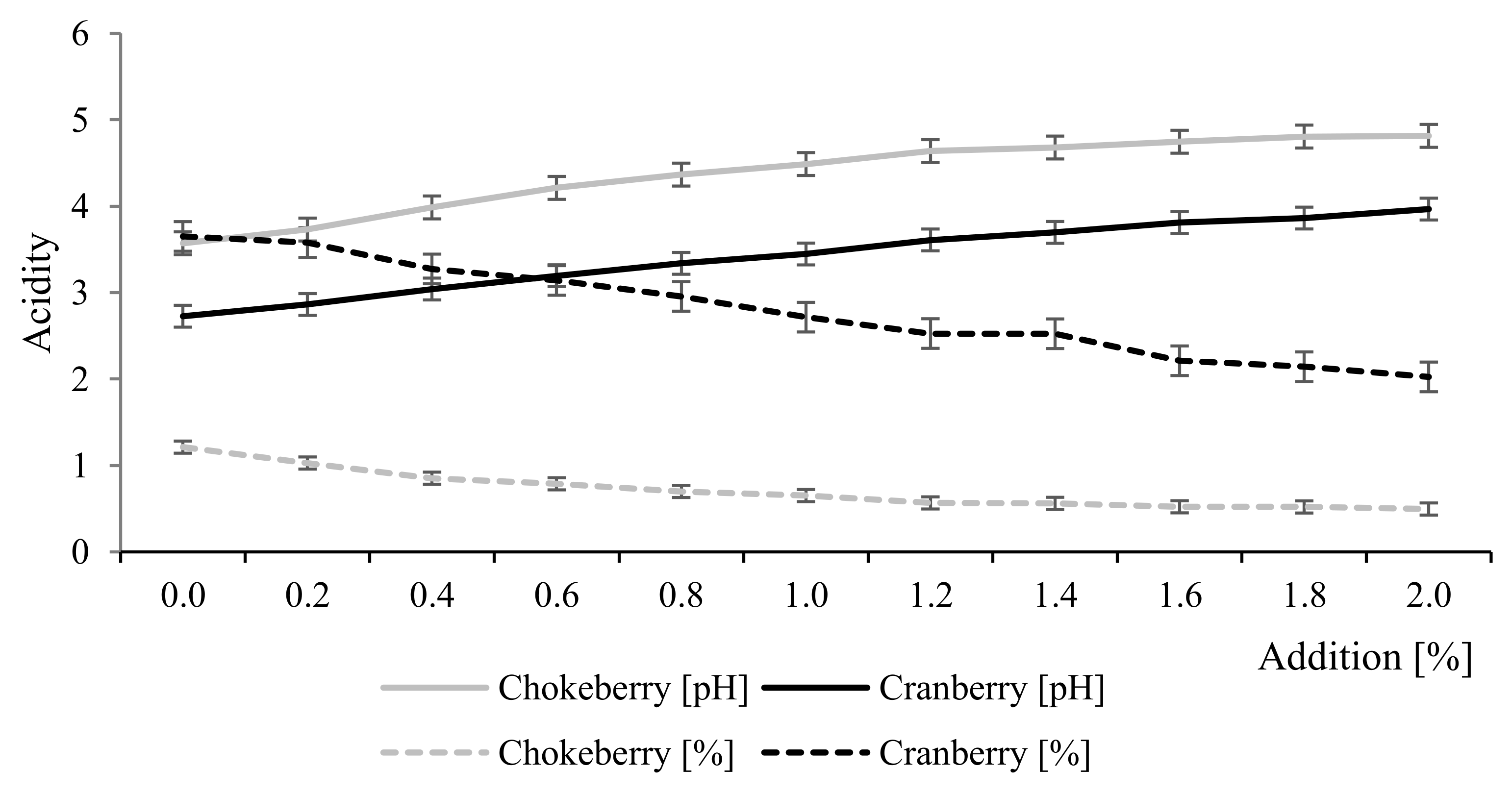
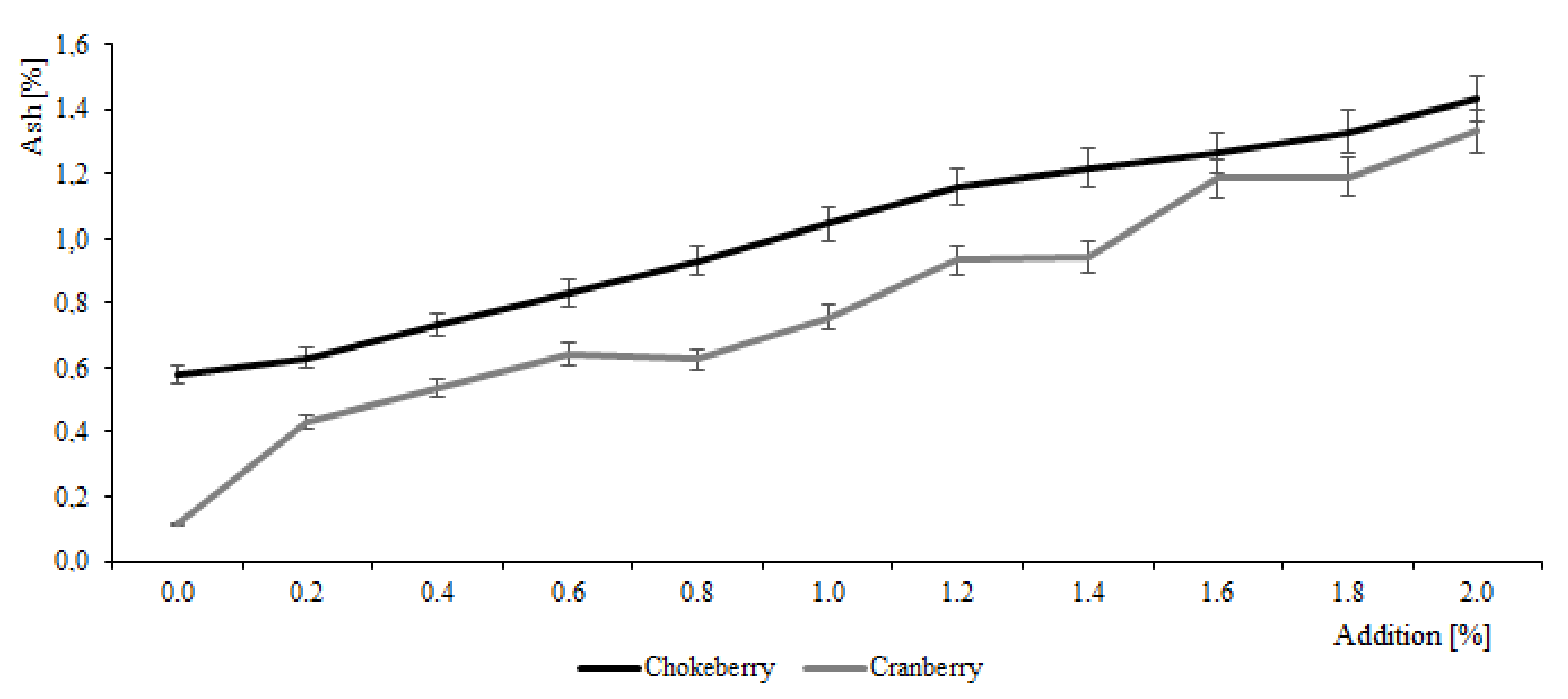
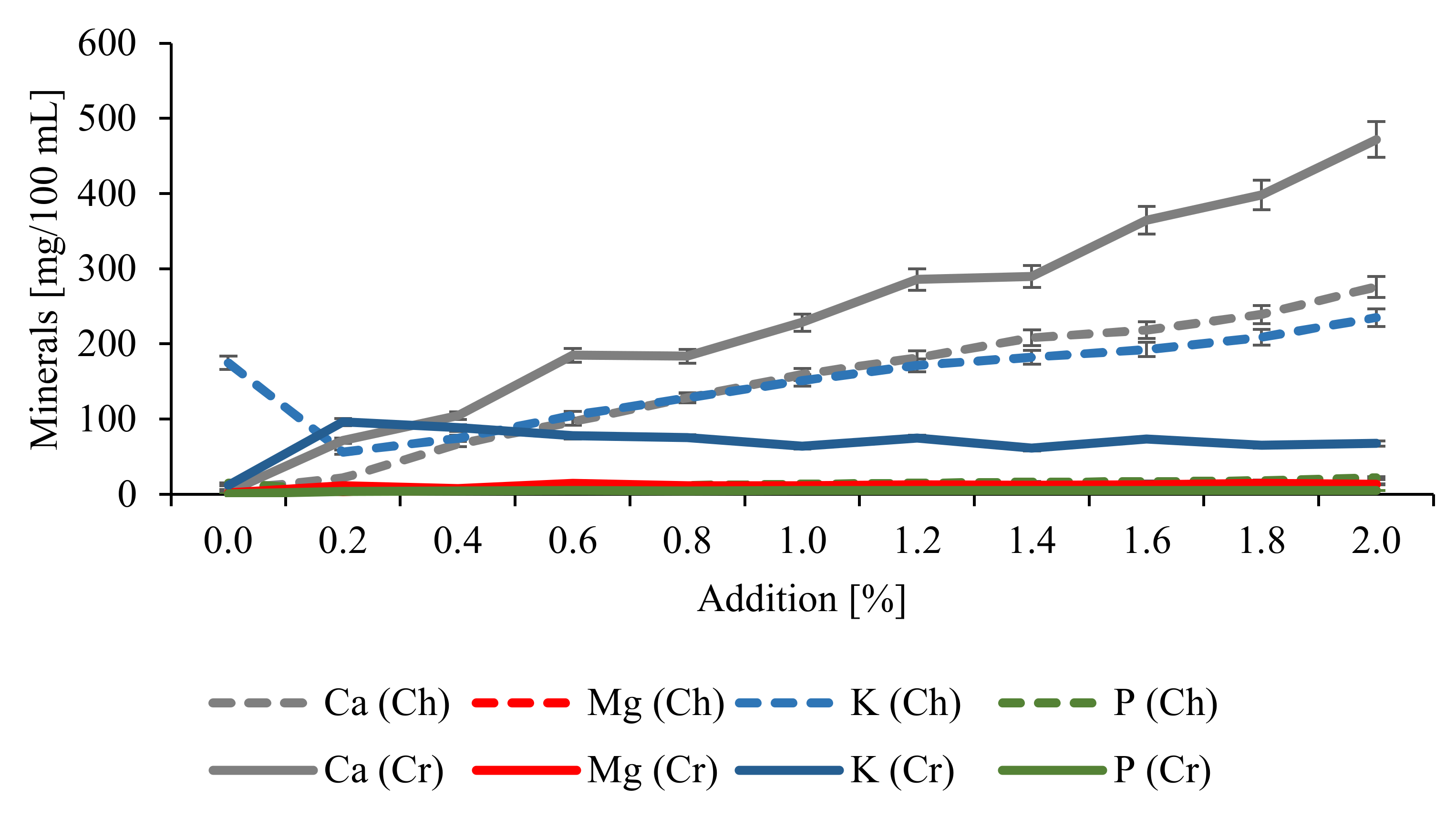
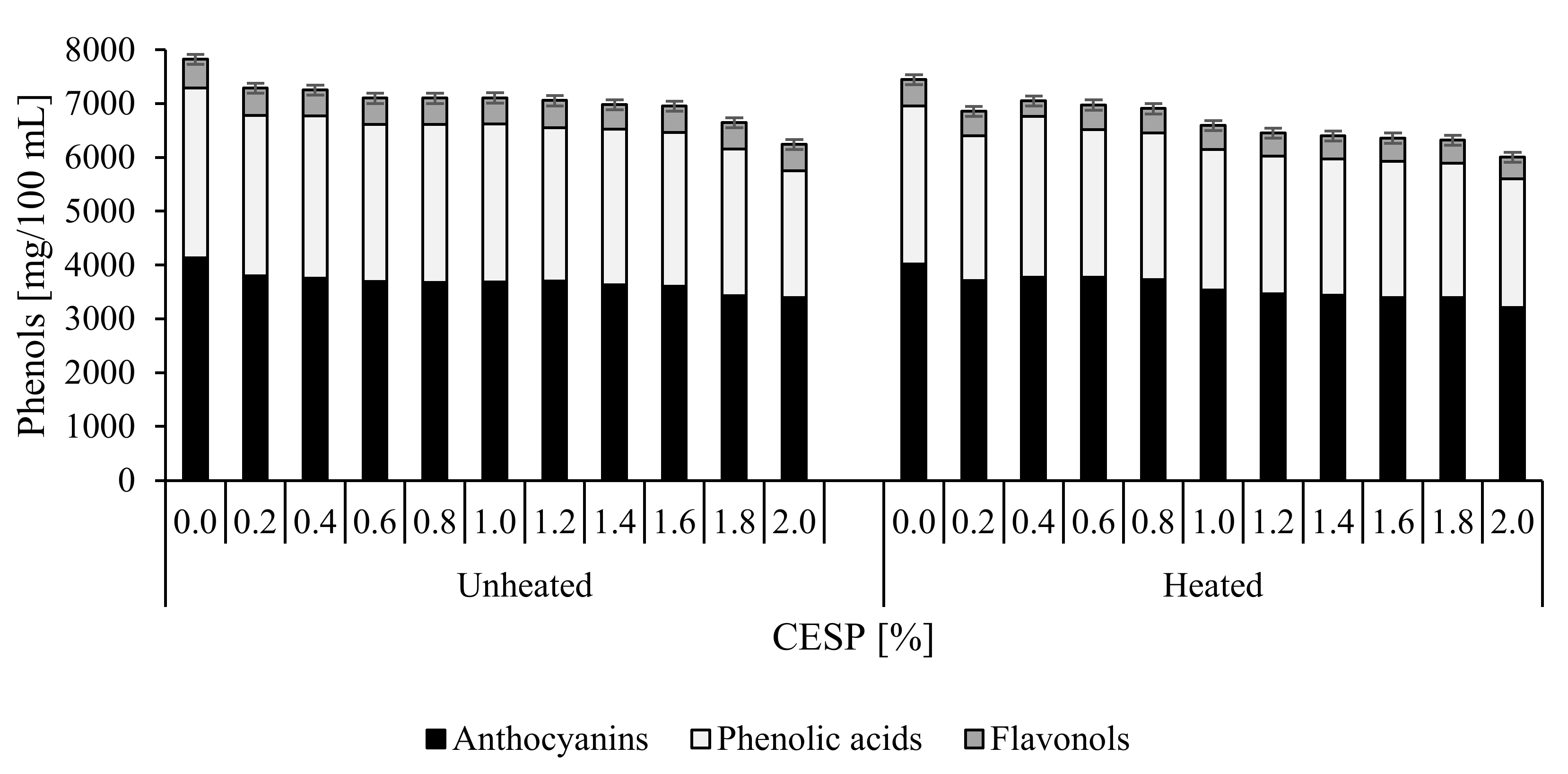
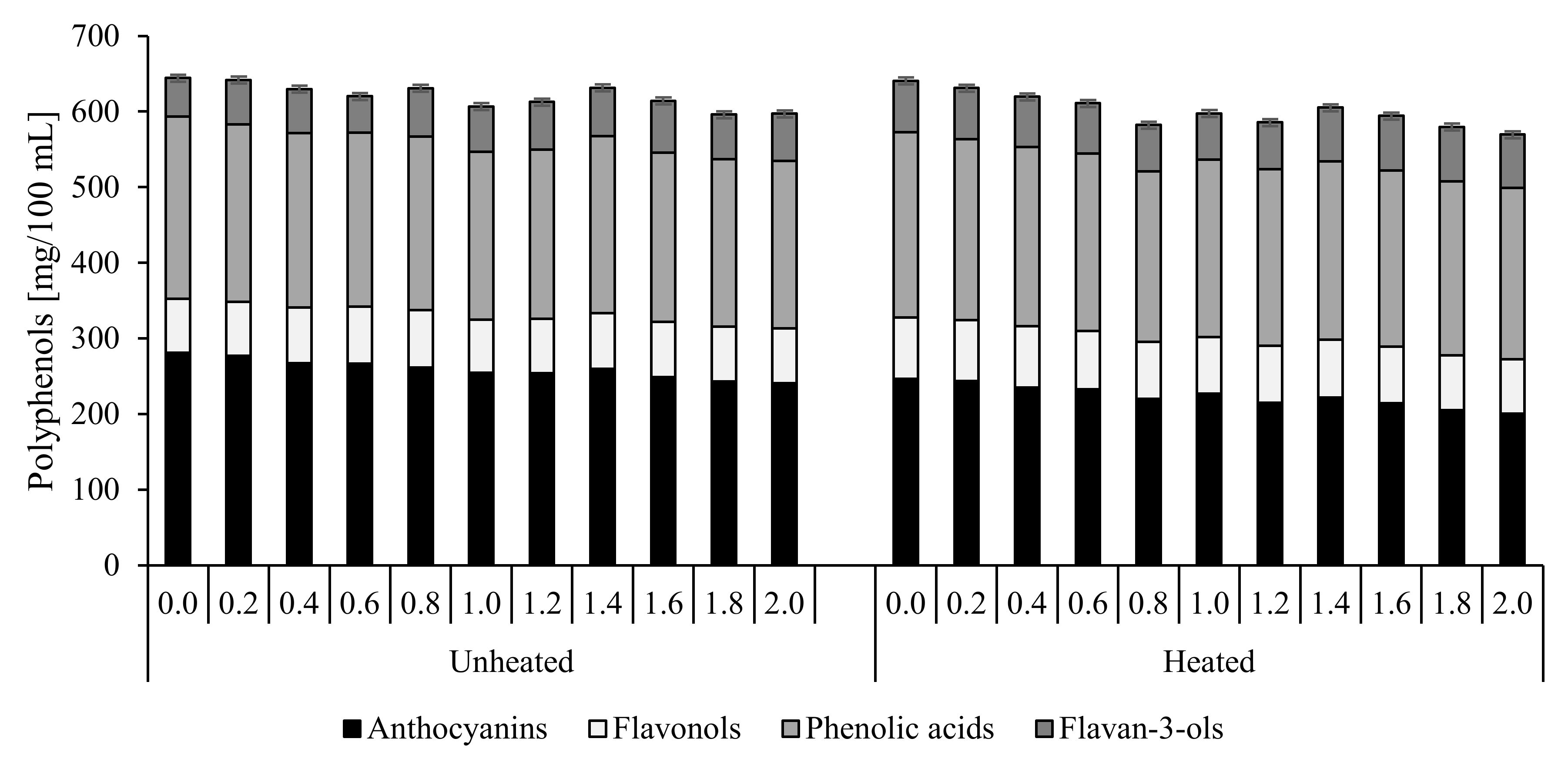
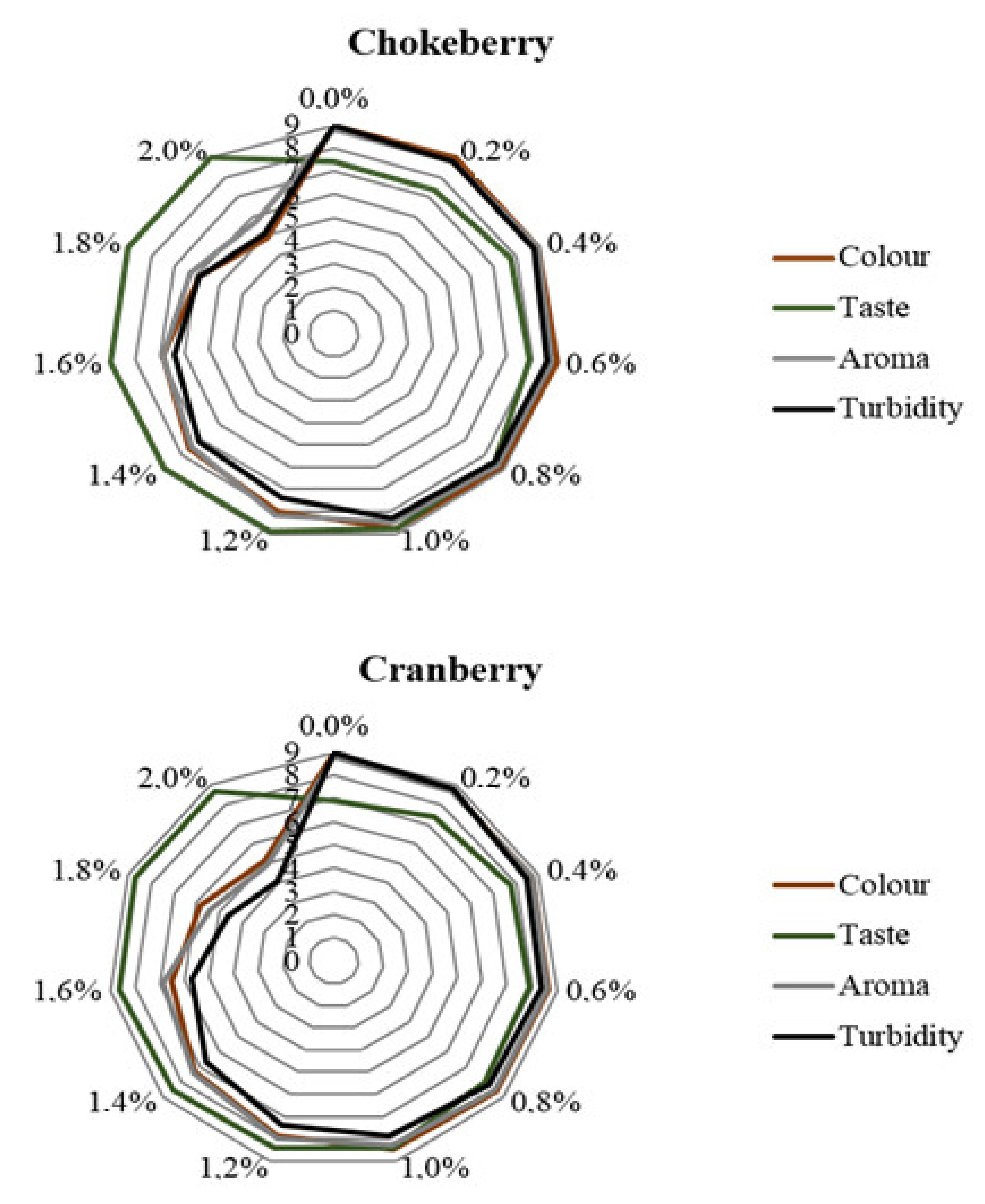

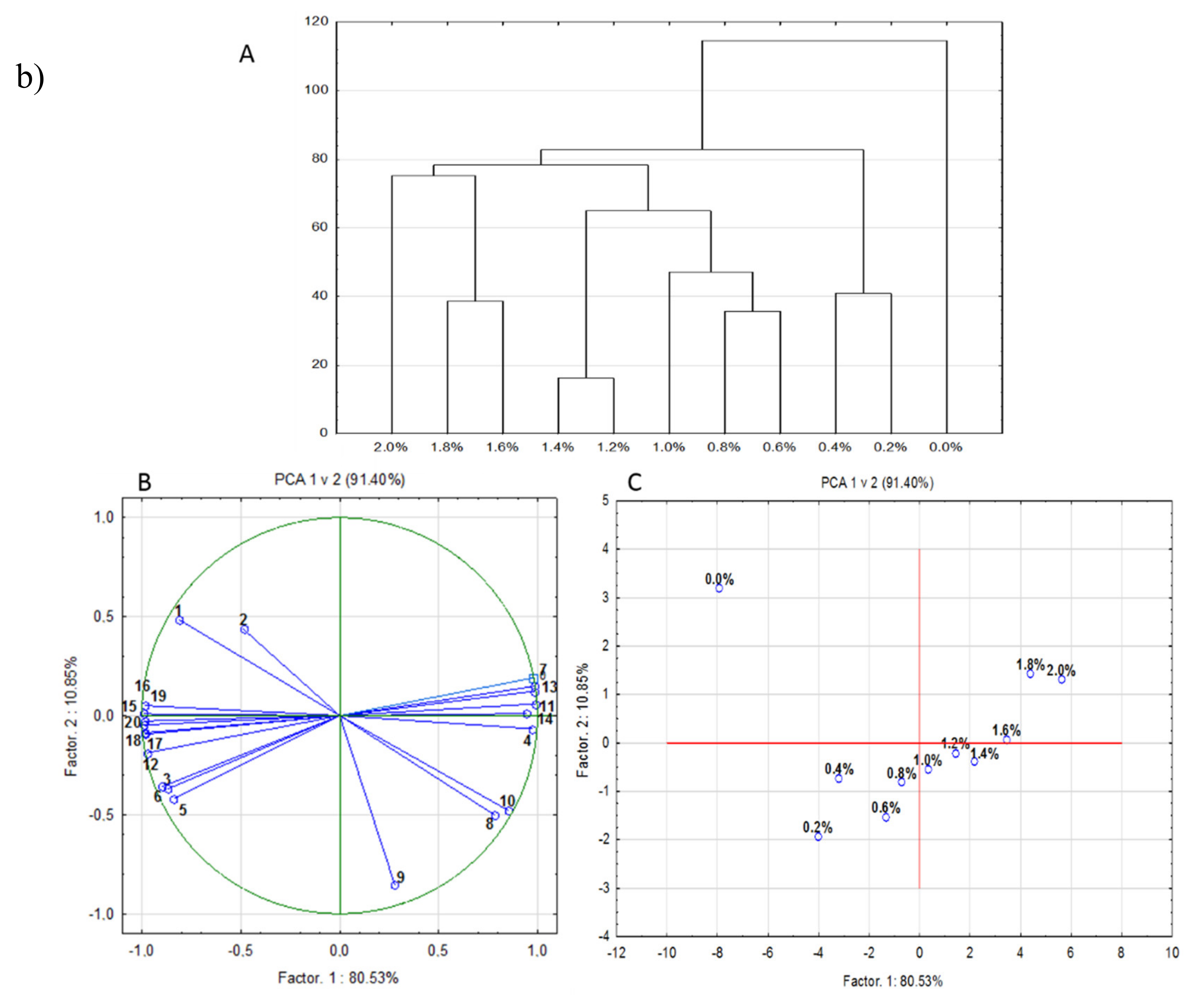
| CESP [%] | Chokeberry Juice | Cranberry Juice | ||||||||||
|---|---|---|---|---|---|---|---|---|---|---|---|---|
| Unheated | Heated | Unheated | Heated | |||||||||
| L* | a* | b* | L* | a* | b* | L* | a* | b* | L* | a* | b* | |
| 0.0 | 49.09 ± 0.101a2 | 60.80 ± 0.12a | 37.65 ± 0.08a | 49.52 ± 0.10a | 59.58 ± 0.12a | 35.70 ± 0.07c | 78.50 ± 0.16h | 33.68 ± 0.07a | 12.31 ± 0.02a | 76.74 ± 0.15h | 35.21 ± 0.07a | 13.01 ± 0.03a |
| 0.2 | 49.06 ± 0.10b | 58.81 ± 0.12b | 29.69 ± 0.06b | 37.26 ± 0.07d | 58.88 ± 0.12b | 43.32 ± 0.09a | 80.27 ± 0.16g | 29.96 ± 0.06b | 10.60 ± 0.02b | 79.62 ± 0.16g | 29.64 ± 0.06b | 10.36 ± 0.02b |
| 0.4 | 48.15 ± 0.10d | 56.56 ± 0.11i | 23.31 ± 0.05d | 39.53 ± 0.08c | 57.41 ± 0.11d | 30.31 ± 0.06e | 81.56 ± 0.16f | 26.81 ± 0.05c | 9.26 ± 0.02c | 82.27 ± 0.16f | 24.10 ± 0.05c | 8.39 ± 0.02c |
| 0.6 | 48.58 ± 0.10c | 55.03 ± 0.11k | 20.28 ± 0.04i | 29.79 ± 0.06i | 56.76 ± 0.11h | 37.68 ± 0.08b | 82.75 ± 0.17e | 24.07 ± 0.05d | 8.26 ± 0.02d | 83.06 ± 0.17e | 21.46 ± 0.04d | 7.45 ± 0.01d |
| 0.8 | 41.79 ± 0.08h | 58.63 ± 0.12c | 24.85 ± 0.05c | 40.53 ± 0.08b | 58.44 ± 0.12c | 25.05 ± 0.05j | 81.81 ± 0.16e | 21.62 ± 0.04e | 7.93 ± 0.02e | 84.41 ± 0.17d | 18.33 ± 0.04e | 6.56 ± 0.01e |
| 1.0 | 39.05 ± 0.08j | 57.87 ± 0.12h | 21.22 ± 0.04f | 35.78 ± 0.07e | 55.33 ± 0.11j | 23.07 ± 0.05k | 84.41 ± 0.17c | 20.40 ± 0.04f | 6.86 ± 0.01f | 85.28 ± 0.17c | 15.93 ± 0.03f | 5.96 ± 0.01f |
| 1.2 | 41.71 ± 0.08h | 58.35 ± 0.12d | 23.58 ± 0.05e | 32.45 ± 0.06f | 57.14 ± 0.11e | 27.70 ± 0.06g | 84.00 ± 0.17c | 18.61 ± 0.04g | 6.61 ± 0.01g | 85.66 ± 0.17c | 15.01 ± 0.03g | 5.58 ± 0.01h |
| 1.4 | 44.02 ± 0.09e | 57.05 ± 0.11g | 21.05 ± 0.04h | 29.01 ± 0.06j | 56.98 ± 0.11g | 33.87 ± 0.07d | 84.90 ± 0.17c | 18.00 ± 0.04h | 6.16 ± 0.01h | 84.29 ± 0.17d | 13.98 ± 0.03h | 5.61 ± 0.01g |
| 1.6 | 40.07 ± 0.08i | 58.02 ± 0.12e | 21.71 ± 0.04g | 27.90 ± 0.06k | 55.98 ± 0.11i | 29.40 ± 0.06f | 83.29 ± 0.17d | 13.29 ± 0.03j | 5.90 ± 0.01i | 87.20 ± 0.17a | 11.07 ± 0.02i | 4.89 ± 0.01j |
| 1.8 | 42.62 ± 0.09f | 55.99 ± 0.11j | 17.50 ± 0.04k | 30.74 ± 0.06h | 57.13 ± 0.11e | 27.19 ± 0.05h | 85.90 ± 0.17b | 15.17 ± 0.03i | 5.00 ± 0.01j | 86.91 ± 0.17b | 10.99 ± 0.02j | 4.81 ± 0.01k |
| 2.0 | 42.34 ± 0.08g | 56.67 ± 0.11h | 19.16 ± 0.04j | 31.29 ± 0.06g | 57.03 ± 0.11f | 27.05 ± 0.05i | 86.50 ± 0.17a | 13.77 ± 0.03j | 4.75 ± 0.01k | 84.42 ± 0.17d | 14.64 ± 0.03g | 5.09 ± 0.01i |
| Process | CESP [%] | Chokeberry Juice | Cranberry Juice | ||||||||||
|---|---|---|---|---|---|---|---|---|---|---|---|---|---|
| OA | CA | ICA | MA | QA | FA | OA | GA | CA | ICA | MA | SA | ||
| Unheated | 0.0 | 91.3 ± 0.0d | 322.3 ± 0.1m | 968.2 ± 0.2c | 15482.6 ± 3.1h | 3224.0 ± 0.6c | 677.9 ± 0.1f | 358.6 ± 0.1f | 161.3 ± 0.0e | 24364.4 ± 4.9h | 1666.4 ± 0.3h | 17435.9 ± 3.5h | 6162.2 ± 1.2f |
| 0.2 | 90.0 ± 0.0d | 236.0 ± 0.0l | 1022.8 ± 0.2b | 15256.7 ± 3.1i | 3221.8 ± 0.6c | 662.9 ± 0.1g | 359.0 ± 0.1f | 145.8 ± 0.0h | 24152.9 ± 4.8i | 1661.8 ± 0.3h | 17401.6 ± 3.5i | 6145.5 ± 1.2f | |
| 0.4 | 96.3 ± 0.0c | 268.6 ± 0.1p | 568.1 ± 0.1i | 16367.9 ± 3.3d | 3023.8 ± 0.6d | 736.4 ± 0.1d | 353.5 ± 0.1g | 160.6 ± 0.0e | 23755.8 ± 4.8j | 1648.6 ± 0.3i | 17137.4 ± 3.4j | 6026.9 ± 1.2g | |
| 0.6 | 85.8 ± 0.0e | 250.2 ± 0.1s | 486.6 ± 0.1o | 14462.8 ± 2.9l | 2938.9 ± 0.6e | 652.6 ± 0.1h | 344.8 ± 0.1h | 167.1 ± 0.0d | 23318.7 ± 4.7l | 1617.5 ± 0.3l | 16799.2 ± 3.4l | 5896.6 ± 1.2h | |
| 0.8 | 81.8 ± 0.0g | 387.0 ± 0.1i | 635.2 ± 0.1e | 14533.6 ± 2.9k | 2490.6 ± 0.5i | 635.2 ± 0.1i | 334.3 ± 0.1i | 145.3 ± 0.0h | 22677.7 ± 4.5m | 1573.5 ± 0.3n | 16334.9 ± 3.3o | 5729.6 ± 1.1i | |
| 1.0 | 76.0 ± 0.0i | 365.2 ± 0.1k | 477.8 ± 0.1 | 14364.9 ± 2.9m | 2454.0 ± 0.5i | 575.1 ± 0.1n | 337.9 ± 0.1i | 147.0 ± 0.0h | 22827.8 ± 4.6m | 1591.0 ± 0.3m | 16415.5 ± 3.3n | 5765.5 ± 1.2i | |
| 1.2 | 80.0 ± 0.0g | 381.1 ± 0.1j | 545.7 ± 0.1k | 13914.4 ± 2.8p | 2435.3 ± 0.5i | 602.9 ± 0.1k | 343.5 ± 0.1h | 154.3 ± 0.0g | 23244.9 ± 4.6l | 1632.4 ± 0.3j | 16660.7 ± 3.3m | 5858.0 ± 1.2h | |
| 1.4 | 75.7 ± 0.0i | 375.2 ± 0.1j | 543.5 ± 0.1k | 13269.0 ± 2.7r | 2267.0 ± 0.5k | 565.2 ± 0.1o | 345.1 ± 0.1h | 149.3 ± 0.0h | 23343.7 ± 4.7l | 1637.2 ± 0.3j | 16793.3 ± 3.4l | 5894.1 ± 1.2h | |
| 1.6 | 79.7 ± 0.0h | 477.4 ± 0.1e | 507.3 ± 0.1n | 14187.5 ± 2.8n | 2390.9 ± 0.5j | 577.9 ± 0.1n | 361.5 ± 0.1e | 176.5 ± 0.0c | 23650.2 ± 4.7k | 1620.7 ± 0.3k | 17152.3 ± 3.4j | 5890.2 ± 1.2h | |
| 1.8 | 73.9 ± 0.0j | 525.9 ± 0.1d | 558.8 ± 0.1j | 14979.5 ± 3.0j | 2384.9 ± 0.5j | 541.3 ± 0.1p | 352.7 ± 0.1g | 159.0 ± 0.0f | 23984.8 ± 4.8j | 1679.8 ± 0.3g | 17032.1 ± 3.4k | 6001.5 ± 1.2g | |
| 2.0 | 79.4 ± 0.0h | 557.8 ± 0.1c | 601.4 ± 0.1g | 14022.4 ± 2.8o | 2349.1 ± 0.5j | 580.6 ± 0.1m | 369.7 ± 0.1g | 169.2 ± 0.0f | 24484.1 ± 4.8j | 1790.2 ± 0.3g | 18012.2 ± 3.4k | 6211.2 ± 1.2g | |
| Heated | 0.0 | 100.5 ± 0.0b | 354.6 ± 0.1r | 1065.0 ± 0.2a | 17030.9 ± 3.4b | 3546.4 ± 0.7a | 745.7 ± 0.1b | 394.5 ± 0.1a | 177.4 ± 0.0c | 26800.8 ± 5.4a | 1833.1 ± 0.4b | 19179.5 ± 3.8a | 6778.4 ± 1.4a |
| 0.2 | 99.0 ± 0.0b | 259.7 ± 0.1r | 1125.0 ± 0.2b | 16782.4 ± 3.4c | 3543.9 ± 0.7a | 729.2 ± 0.1c | 394.9 ± 0.1a | 160.3 ± 0.0e | 26568.1 ± 5.3b | 1828.0 ± 0.4b | 19141.7 ± 3.8a | 6760.0 ± 1.4a | |
| 0.4 | 105.9 ± 0.0a | 295.5 ± 0.1o | 624.9 ± 0.1e | 18004.7 ± 3.6a | 3326.2 ± 0.7b | 810.0 ± 0.2a | 388.8 ± 0.1b | 176.6 ± 0.0c | 26131.3 ± 5.2d | 1813.5 ± 0.4c | 18851.2 ± 3.8b | 6629.6 ± 1.3b | |
| 0.6 | 94.4 ± 0.0c | 275.2 ± 0.1p | 535.3 ± 0.1l | 15909.1 ± 3.2e | 3232.8 ± 0.6b | 717.9 ± 0.1d | 379.3 ± 0.1c | 183.8 ± 0.0b | 25650.6 ± 5.1e | 1779.2 ± 0.4e | 18479.1 ± 3.7d | 6486.3 ± 1.3c | |
| 0.8 | 90.0 ± 0.0d | 425.7 ± 0.1f | 698.8 ± 0.1d | 15987.0 ± 3.2e | 2739.6 ± 0.5f | 698.7 ± 0.1e | 367.7 ± 0.1e | 159.9 ± 0.0f | 24945.4 ± 5.0g | 1730.9 ± 0.3f | 17968.4 ± 3.6g | 6302.6 ± 1.3e | |
| 1.0 | 83.6 ± 0.0f | 401.7 ± 0.1h | 525.6 ± 0.1m | 15801.4 ± 3.2f | 2699.4 ± 0.5g | 632.6 ± 0.1i | 371.7 ± 0.1d | 161.7 ± 0.0e | 25110.6 ± 5.0f | 1750.1 ± 0.4f | 18057.1 ± 3.6f | 6342.1 ± 1.3e | |
| 1.2 | 88.0 ± 0.0e | 419.2 ± 0.1f | 600.3 ± 0.1g | 15305.8 ± 3.1i | 2678.8 ± 0.5g | 663.2 ± 0.1g | 377.9 ± 0.1c | 169.7 ± 0.0d | 25569.4 ± 5.1e | 1795.6 ± 0.4e | 18326.8 ± 3.7e | 6443.8 ± 1.3d | |
| 1.4 | 83.2 ± 0.0f | 412.7 ± 0.1g | 597.8 ± 0.1h | 14596.0 ± 2.9k | 2493.7 ± 0.5i | 621.7 ± 0.1j | 379.7 ± 0.1c | 164.2 ± 0.0e | 25678.1 ± 5.1e | 1800.9 ± 0.4d | 18472.6 ± 3.7d | 6483.5 ± 1.3c | |
| 1.6 | 87.7 ± 0.0e | 525.1 ± 0.1d | 558.1 ± 0.1j | 15606.3 ± 3.1g | 2629.9 ± 0.5g | 635.7 ± 0.1i | 397.6 ± 0.1a | 194.2 ± 0.0a | 26015.2 ± 5.2d | 1782.8 ± 0.4e | 18867.6 ± 3.8b | 6479.2 ± 1.3c | |
| 1.8 | 81.3 ± 0.0g | 578.5 ± 0.1b | 614.7 ± 0.1f | 16477.5 ± 3.3d | 2623.4 ± 0.5g | 595.4 ± 0.1l | 388.0 ± 0.1b | 174.9 ± 0.0c | 26383.3 ± 5.3b | 1847.7 ± 0.4a | 18735.4 ± 3.7c | 6601.6 ± 1.3b | |
| 2.0 | 87.3 ± 0.0e | 613.6 ± 0.1a | 661.6 ± 0.1e | 15424.6 ± 3.1h | 2584.0 ± 0.5h | 638.6 ± 0.1i | 398.0 ± 0.1b | 181.2 ± 0.0c | 27213.2 ± 5.3b | 1900.7 ± 0.4a | 19105.4 ± 3.7c | 6701.3 ± 1.3b | |
| Minerals | Sum [mg/100 g] | Ratio of Minerals [%] |
|---|---|---|
| Al | 0.00 | 0.00 |
| As | 0.03 | 0.00 |
| Ca | 27695.83 | 27.70 |
| Cd | 0.01 | 0.00 |
| Cr | 0.00 | 0.00 |
| Cu | 0.08 | 0.00 |
| Fe | 0.52 | 0.00 |
| K | 57.59 | 0.06 |
| Mg | 352.28 | 0.35 |
| Mn | 0.12 | 0.00 |
| Mo | 0.00 | 0.00 |
| Na | 103.89 | 0.10 |
| Ni | 0.00 | 0.00 |
| P | 85.53 | 0.09 |
| Pb | 0.00 | 0.00 |
| S | 94.78 | 0.10 |
| Sr | 22.35 | 0.02 |
| Zn | 0.00 | 0.00 |
| Tentative Identification | λmax [nm] | [H − M]− (m/z) | MS/MS Fragments (m/z) | Chokeberry | Cranberry |
|---|---|---|---|---|---|
| Cyanidin-3-hexoside-(epi)catechin | 520 | 737+ | 575/423/287 | x | |
| Neochlorogenic acid | 323 | 353 | 191 | x | |
| Cyanidin-3-pentoside-(epi)catechin | 520 | 707+ | 557/329/287 | x | |
| ( + )-catechin | 280 | 289 | 245/203 | x | |
| Cyanidin-3-hexoside-(epi)cat-(epi)cat | 520 | 1025+ | 575/409/287 | x | |
| 3-O-p-Coumaroylquinic acid | 310 | 337 | 191 | x | x |
| Delfinidyn-3-O-glucoside | 520 | 465+ | 303 | x | |
| p-Coumaroyl-hexose isomer | 310 | 325 | 163 | x | |
| p-Coumaroyl-hexose isomer | 310 | 325 | 163 | x | |
| B-type procyanidin-dimer | 280 | 577 | 289 | x | |
| Cyanidin-3-O-galactoside | 516 | 449+ | 287 | x | x |
| Chlorogenic acid | 323 | 353 | 191 | x | x |
| Cryptochlorogenic acid | 323 | 353 | 191 | x | |
| Caffeoyl dihexoside | 320 | 503 | 341/179 | x | |
| Caffeoyl hexoside | 320 | 341 | 179 | x | |
| Caffeoyl hexoside isomer | 320 | 341 | 179 | x | |
| Cyanidin-3-O-glucoside | 517 | 449+ | 287 | x | x |
| Sinapoyl-hexose | 320 | 385 | 223 | x | |
| Delphinidin-3-O-arabinoside | 520 | 435 | 303 | x | |
| Peonidin-3-O-galactoside | 515 | 463+ | 301 | x | |
| Cyanidin-3-O-arabinoside | 515 | 419+ | 287+ | x | x |
| (−)-Epicatechin | 280 | 289 | 245/203 | x | |
| A-type PA-trimer | 280 | 863 | 289 | x | |
| Cyanidin-3-O-xyloside | 515 | 419+ | 287+ | x | |
| Peonidin-3-O-glucoside | 515 | 463+ | 301 | x | |
| Peonidin-3-O-arabinoside | 515 | 433+ | 301 | x | |
| Malvidin-3-O-galactoside | 515 | 493 | 331 | x | |
| Malwidin-3-O-arabinoside | 520 | 463+ | 331 | x | |
| A-type PA-tetramer | 280 | 1151 | 289 | x | |
| Quercetin-dihexoside | 352 | 625 | 445/301 | x | |
| Quercetin-dihexoside | 352 | 625 | 445/301 | x | |
| Quercetin-3-O-vicianoside | 353 | 595 | 432/301 | x | |
| Quercetin-3-O-robinobioside | 353 | 609 | 463/301 | x | |
| Quercetin-3-O-rutinoside | 353 | 609 | 463/301 | x | x |
| Myricetin-3-O-arabinoside | 355 | 449 | 317 | x | |
| Myricetin-3-O-galactoside | 355 | 479 | 317 | x | |
| Quercetin-3-O-galactoside | 352 | 463 | 301 | x | x |
| Quercetin-3-O-glucoside | 352 | 463 | 301 | x | x |
| Myricetin-3-O-glucoside | 355 | 479 | 317 | x | |
| Eriodictyol-glucuronide | 280 | 463 | 287 | x | |
| Isorhamnetin pentosylhexoside | 352 | 609 | 315 | x | |
| Quercetin-O-deoxyhexose-deoxyhexoside | 352 | 593 | 433/301 | x | |
| Isorhamnetin rhamnosyl hexoside isomer | 352 | 623 | 463/315 | x | |
| Isorhamnetin rhamnosyl hexoside isomer | 352 | 623 | 421/315 | x | |
| Isorhamnetin-3-O-galactoside | 350 | 477 | 315 | x | |
| Syringetin-3-O-galactoside | 358 | 507 | 330 | x | |
| Methoxyquercetin-pentoside | 350 | 447 | 315 | x | |
| Isorhamnetin-3-O-arabinoside | 352 | 447 | 315 | x | |
| Quercetin-3-O-(6”p-coumaroyl)-galactoside | 350 | 609 | 301 | x |
| Addition [%] | Antioxidant Activity [mmol TE/mL] | |||||||
|---|---|---|---|---|---|---|---|---|
| FRAP | ABTS | |||||||
| Unheated | Heated | Unheated | Heated | |||||
| Cranberry | Chokeberry | Cranberry | Chokeberry | Cranberry | Chokeberry | Cranberry | Chokeberry | |
| 0.0 | 1.38 ± 0.001a2 | 10.94 ± 0.02A | 1.31 ± 0.00b | 9.98 ± 0.02B | 1.48 ± 0.00a | 9.79 ± 0.02A | 1.41 ± 0.00b | 9.16 ± 0.02B |
| 0.2 | 1.01 ± 0.00g | 7.61 ± 0.02B | 1.00 ± 0.00g | 7.47 ± 0.01C | 1.16 ± 0.00d | 7.32 ± 0.01C | 1.03 ± 0.00g | 7.27 ± 0.02C |
| 0.4 | 1.19 ± 0.00c | 6.88 ± 0.01G | 1.18 ± 0.00c | 6.82 ± 0.01G | 1.25 ± 0.00c | 7.08 ± 0.01D | 1.21 ± 0.00c | 7.01 ± 0.01D |
| 0.6 | 1.03 ± 0.00g | 5.69 ± 0.01K | 1.00 ± 0.00c | 5.38 ± 0.01L | 1.15 ± 0.00d | 5.27 ± 0.01I | 1.05 ± 0.00g | 5.20 ± 0.01I |
| 0.8 | 1.18 ± 0.00c | 5.14 ± 0.01M | 1.11 ± 0.00e | 5.11 ± 0.01M | 1.09 ± 0.00f | 5.07 ± 0.01J | 1.01 ± 0.00gh | 5.05 ± 0.01J |
| 1.0 | 1.06 ± 0.00f | 6.45 ± 0.01I | 1.03 ± 0.00g | 6.05 ± 0.01J | 1.14 ± 0.00d | 4.95 ± 0.01J | 1.08 ± 0.00f | 4.58 ± 0.01K |
| 1.2 | 1.32 ± 0.00b | 6.10 ± 0.01J | 1.11 ± 0.00e | 5.64 ± 0.01K | 1.09 ± 0.00f | 5.53 ± 0.01H | 1.05 ± 0.00g | 5.22 ± 0.01I |
| 1.4 | 0.88 ± 0.00j | 7.29 ± 0.01D | 0.84 ± 0.00k | 7.20 ± 0.01D | 1.02 ± 0.00g | 7.06 ± 0.01D | 0.90 ± 0.00i | 7.03 ± 0.01D |
| 1.6 | 1.05 ± 0.00f | 7.04 ± 0.01F | 1.01 ± 0.00g | 6.55 ± 0.01H | 0.99 ± 0.00h | 6.42 ± 0.01F | 0.97 ± 0.00h | 6.38 ± 0.01F |
| 1.8 | 1.18 ± 0.00c | 7.44 ± 0.01C | 1.15 ± 0.00d | 7.21 ± 0.01D | 1.13 ± 0.00e | 7.07 ± 0.01D | 1.11 ± 0.00e | 7.03 ± 0.02D |
| 2.0 | 0.94 ± 0.00h | 7.11 ± 0.01E | 0.91 ± 0.00i | 6.63 ± 0.01H | 1.09 ± 0.00f | 6.50 ± 0.01E | 0.96 ± 0.00h | 6.25 ± 0.01G |
© 2020 by the authors. Licensee MDPI, Basel, Switzerland. This article is an open access article distributed under the terms and conditions of the Creative Commons Attribution (CC BY) license (http://creativecommons.org/licenses/by/4.0/).
Share and Cite
Lachowicz, S.; Oszmiański, J.; Wilczyńska, M.; Zaguła, G.; Saletnik, B.; Puchalski, C. Impact Mineralization of Chokeberry and Cranberry Fruit Juices Using a New Functional Additive on the Protection of Bioactive Compounds and Antioxidative Properties. Molecules 2020, 25, 659. https://doi.org/10.3390/molecules25030659
Lachowicz S, Oszmiański J, Wilczyńska M, Zaguła G, Saletnik B, Puchalski C. Impact Mineralization of Chokeberry and Cranberry Fruit Juices Using a New Functional Additive on the Protection of Bioactive Compounds and Antioxidative Properties. Molecules. 2020; 25(3):659. https://doi.org/10.3390/molecules25030659
Chicago/Turabian StyleLachowicz, Sabina, Jan Oszmiański, Martyna Wilczyńska, Grzegorz Zaguła, Bogdan Saletnik, and Czesław Puchalski. 2020. "Impact Mineralization of Chokeberry and Cranberry Fruit Juices Using a New Functional Additive on the Protection of Bioactive Compounds and Antioxidative Properties" Molecules 25, no. 3: 659. https://doi.org/10.3390/molecules25030659
APA StyleLachowicz, S., Oszmiański, J., Wilczyńska, M., Zaguła, G., Saletnik, B., & Puchalski, C. (2020). Impact Mineralization of Chokeberry and Cranberry Fruit Juices Using a New Functional Additive on the Protection of Bioactive Compounds and Antioxidative Properties. Molecules, 25(3), 659. https://doi.org/10.3390/molecules25030659







